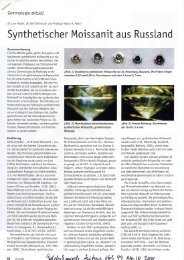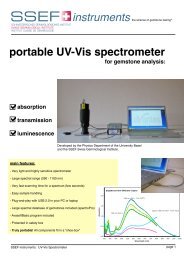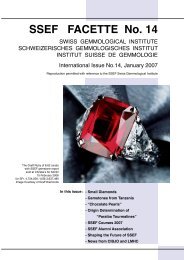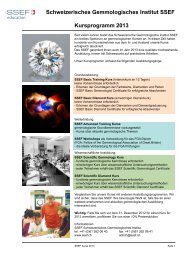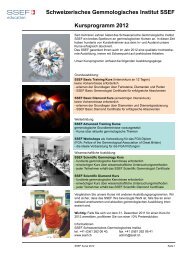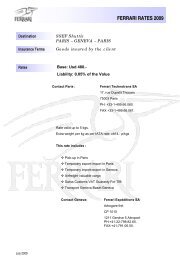SSEF FACETTE No. 17
SSEF FACETTE No. 17
SSEF FACETTE No. 17
You also want an ePaper? Increase the reach of your titles
YUMPU automatically turns print PDFs into web optimized ePapers that Google loves.
Diamonds with a “star”: Asteriated diamonds<br />
During the last September Show in Hong Kong,<br />
we were able to buy eight asteriated diamonds<br />
(see figure 1) selected from a lot of similar polished<br />
slabs. We were astonished to see such a quantity<br />
of these peculiar diamonds (several tens of carats)<br />
available on the market. Most of them were of fine<br />
quality. The characteristic features of these asteriated<br />
diamonds are grey to brownish grey distinct<br />
growth sectors, similar to flower petals, starting from<br />
the centre of the more or less transparent diamond<br />
(figure 2). The samples selected have an average<br />
weight of 0.33 ct and the largest specimen shown<br />
on the photo is about 8.4 mm in diameter with a<br />
thickness of 0.45 mm. The base of each slab is<br />
plane polished and the top is a flat modified brilliant.<br />
Our interest in these asteriated diamonds started<br />
in 1998 when collectors brought some of these diamonds<br />
to the <strong>SSEF</strong> to be tested. Based on infrared<br />
absorption analysis, we could demonstrate immediately<br />
that these greyish-brown sectors showed a<br />
distinctly higher concentration hydrogen than the<br />
transparent sectors in between. This preliminary<br />
study was later followed up by a thorough study,<br />
with which we collaborated, on similar asteriated<br />
diamonds, published in 2004 (Rondeau et al., Diamond<br />
& Related Materials 13, (2004) 1658-1673).<br />
In the last few years we have only rarely encountered<br />
diamonds like these. Therefore we were<br />
delighted to be offered such a large choice of good<br />
quality asteriated diamonds and to add a number of<br />
them to our <strong>SSEF</strong> research collection.<br />
Asteriated diamonds may become fashionable in<br />
the future because they are quite affordable when<br />
one compares their price per carat to brilliants and,<br />
to the connoisseur, really attractive. We are looking<br />
forward to seeing how jewellers will use these<br />
stones in their creative designs in the near future.<br />
author: J-P. Chalain<br />
<strong>SSEF</strong> Facette <strong>No</strong>. <strong>17</strong>, © 2010<br />
<strong>SSEF</strong> Research<br />
Fig. 1: These eight asteriated diamonds were bought in<br />
September 2009 at the Hong Kong Jewellery Show. The<br />
largest specimen on the photo is 8.4 mm in diameter.<br />
© <strong>SSEF</strong><br />
Fig. 2: Microphotography (mag. 15x) showing details of<br />
the hydrogen-rich sectors. © <strong>SSEF</strong><br />
Fig. 3: This scheme illustrates the peculiar hydrogen affinity for specific crystallographic sectors in diamond and explains<br />
how several slabs sawn out of one single crystal may look quite different. © Rondeau et al. 2004<br />
page 13



